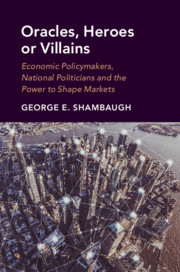 Oracles, Heroes or Villains
Oracles, Heroes or Villains Book contents
- Oracles, Heroes or Villains
- Oracles, Heroes or Villains
- Copyright page
- Dedication
- Contents
- Figures
- Preface
- Acknowledgments
- Abbreviations
- 1 Reaching for the Bazooka
- 2 Preferences, Power and Predictions
- 3 The Argentine Tango
- 4 The Federal Reserve Goes Political
- 5 A Greek Tragedy
- 6 Managing Markets in Turbulent Times
- Bibliography
- Index
4 - The Federal Reserve Goes Political
Published online by Cambridge University Press: 09 September 2019
- Oracles, Heroes or Villains
- Oracles, Heroes or Villains
- Copyright page
- Dedication
- Contents
- Figures
- Preface
- Acknowledgments
- Abbreviations
- 1 Reaching for the Bazooka
- 2 Preferences, Power and Predictions
- 3 The Argentine Tango
- 4 The Federal Reserve Goes Political
- 5 A Greek Tragedy
- 6 Managing Markets in Turbulent Times
- Bibliography
- Index
Summary
In the wake of the recent financial crisis, Federal Reserve Chairman Ben Bernanke argued repeatedly that fostering healthy growth and job creation required legislative action. He warned that continued political battles over fiscal and monetary policy, financial regulation and the debt ceiling were “deeply irresponsible” and would have “catastrophic consequences for the economy that could last for decades.” At the same time, like Alan Greenspan before him, Bernanke joined secretaries of the Treasury and other technocrats in guiding and enabling legislation, helping presidents outmaneuver critics and compensating for political uncertainty when political battles between the President and Congress stalled economic legislation. Far from being apolitical actors, these technocrats manipulated authority, exploited deference from politicians and business leaders, and alternately bolstered and challenged national politicians in order to shape US economic policy, manage market behavior and coordinate global activities before, during and after the recent financial crises.
Keywords
- Type
- Chapter
- Information
- Oracles, Heroes or VillainsEconomic Policymakers, National Politicians and the Power to Shape Markets, pp. 103 - 151Publisher: Cambridge University PressPrint publication year: 2019
